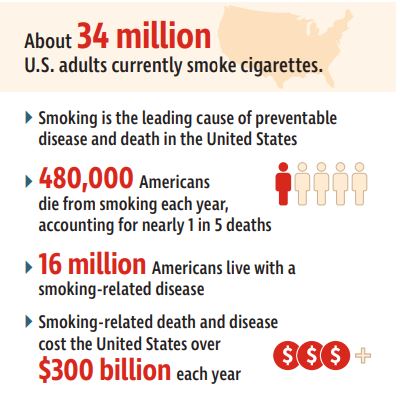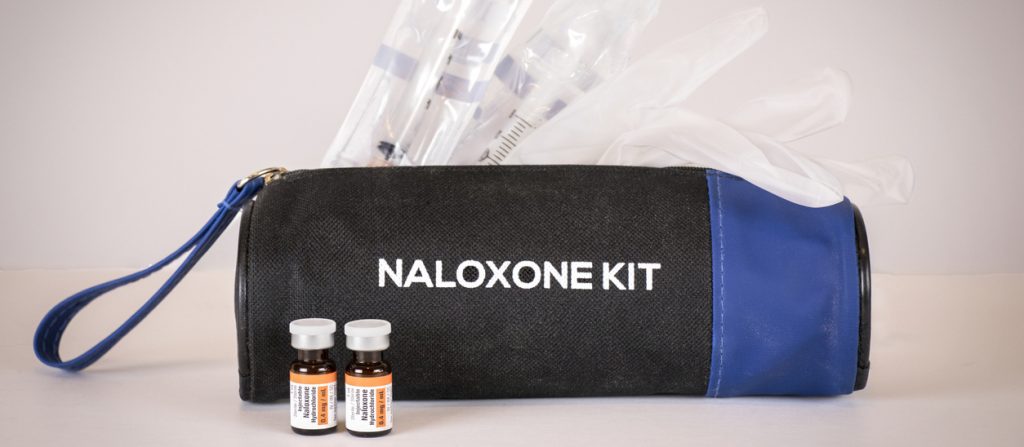Despite declining national smoking rates, smoking remains a significant public health issue and is the leading cause of preventable disease and death in the United States, affecting more than 16 million Americans. Smoking has been proven to cause cardiovascular diseases, chronic obstructive pulmonary disease (COPD), reproductive health outcomes, and 12 types of cancers.
The U.S. Department of Health & Human Services (HHS) Office of the Surgeon General reports that 70% of the 34 million U.S. adult smokers say they want to quit. But the highly addictive nature of nicotine makes that difficult. And now we also face the growing use of electronic nicotine-delivery systems referred to as vaping. Electronic cigarettes (e-cigarettes), vape pens and other vaping devices have been promoted as a safer alternative to smoking combustible tobacco products. However, growing evidence is rapidly uncovering the dangers of vaping on the lungs. Thus, electronic nicotine-delivery systems use must be considered a part of the public health concern, and should not be considered a safe alternative to tobacco smoking.
Access key to success
Access to prescribing medical professionals once the desire to quit smoking arises is a barrier to success. For some, prescriber appointments create obstacles such as a delayed time from the desire to quit to the availability of an appointment. This may result in waning confidence or diminished desire to quit prior to the appointment.
Here’s another instance where pharmacists can make a key difference in timely access to health advice and products. Smoking-cessation medications are either prescription or over-the-counter (OTC), making pharmacists key suppliers and educators of smoking-cessation aids. The proven capabilities and accessibility of pharmacists have spurred states to develop statewide protocols, standing orders and statutes in several categories, including smoking cessation, as a means to address public health concerns.
Note that statewide protocols currently address cessation from tobacco products as described in clinical guidelines and according to FDA-approved product labeling. But pharmacists can still provide valuable counseling and education on the dangers of vaping until electronic nicotine-delivery systems are included in legislation.
Medications for smoking cessation

Smoking-cessation products include nicotine replacement therapy (NRT) and non-nicotine prescription cessation products.
- Nicotine replacement therapy allows the gradual withdrawal from smoking with the use of decreasing amounts of nicotine over time. Dosage forms include skin patches, chewing gum, nasal spray, oral inhaler and lozenges. They are available by prescription and over-the-counter, with age restrictions.
- Non-nicotine smoking cessation therapy: Oral prescription medications — varenicline tartrate (brand name Chantix) and bupropion hydrochloride (Zyban) — containing active ingredients other than nicotine.
Types of pharmacist statewide authority for smoking cessation
States have employed mechanisms for pharmacist autonomy regarding smoking-cessation interventions. The spectrum of autonomy includes statewide protocols, standing orders, tobacco-specific prescriptive authority statutes, and CPAs.
Statewide protocols give pharmacists independent prescribing autonomy, acting as the prescriber of record. Standing orders designate a state prescriber, empowering pharmacists to dispense under the blanket order. State statutes embed pharmacist prescribing of smoking-cessation products within the law as a part of pharmacy practice. CPAs are formal relationships established between individual prescribers and pharmacists that describe functions such as prescriptive authority.
Similarities in statewide protocols for smoking cessation
Statewide protocols for smoking cessation between states have similar structures that detail pharmacist qualifications and continuing education, patient screening and eligibility, specified medications and dosages, and counseling, reporting and referral requirements.
Statewide protocols for smoking cessations overwhelmingly put age restrictions on pharmacist prescribing, requiring patients to be 18 years or older. Other health or situational restrictions — pregnancy, seizure history, eating disorders — are similarly imposed in smoking cessation statewide protocols, requiring referral to a physician.
Differences in statewide protocols for smoking cessation
- Medication type: Some states such as Colorado, Indiana and New Mexico allow autonomous pharmacist prescribing of all medications approved by the FDA for smoking cessation. Other states such as Minnesota, Iowa and California only allow prescribing of nicotine-replacement therapy products.
- Level of counseling requirement: This varies from a referral to the state Quitline resources as in Colorado to Arizona’s requirement for patient enrollment in a smoking-cessation program. New Mexico requires pharmacists to provide patients a 90-minute educational session.
- Level of pharmacist qualifications: These vary from holding a valid pharmacist license to completion of an Accreditation Council for Pharmacy Education (ACPE) accredited program in smoking cessation.
Expanding pharmacist prescribing authority to improve health
With approximately 480,000 deaths attributed to smoking each year in the U.S., smoking cessation is a prominent public health issue. Increased utilization of pharmacists via statewide smoking-cessation protocols is a logical method to increase medication access, education, support and positive health outcomes for patients.
Pharmacists are well-placed in the community, as nearly 90% of Americans live within five miles of a community pharmacy, many of which have extended hours of access. A study in the Journal of Managed Care Specialty Pharmacy (JMCP) reported that smoking cessation interventions by pharmacists yielded comparable quit rates to other health professionals.
Pharmacists are valuable, accessible health professionals educated in smoking cessation as recognized by the most-recent U.S. Public Health Services Smoking Cessation: A Report of the Surgeon General. The American Association of Colleges of Pharmacy reports smoking-cessation content is integrated into the required pharmacy curriculum at 98.9% of schools of pharmacy. The 5 As of smoking cessation — ask, advise, assess, assist, arrange (PDF version here) — are characteristic counseling strategies taught to and utilized in practice by pharmacists to help patients quit using all forms of tobacco or vaping products. Some statewide protocols, including those in Colorado and New Mexico, incorporate the 5 As into the protocols’ general requirements.
Pharmacists are ideally positioned to aid in smoking cessation. Expansion of pharmacist prescriptive authority through statewide protocols benefits patients by enabling them to access prescription medications and professional advice from pharmacists at the exact moment of stated need and desire to quit, increasing quit success rates and positive public health outcomes overall.
Resources
Advancing Pharmacist Prescribing Privileges: Is It Time? Journal of the American Pharmacists Association (JAPhA)
Pharmacist Prescriptive Authority for Smoking Cessation Medications in the United States, JAPhA
Smoking & Tobacco Use Fast Facts, Centers for Disease Control and Prevention (CDC)
What Happens When You Vape, Johns Hopkins Medicine
Five Vaping Facts You Need to Know, Johns Hopkins Medicine





